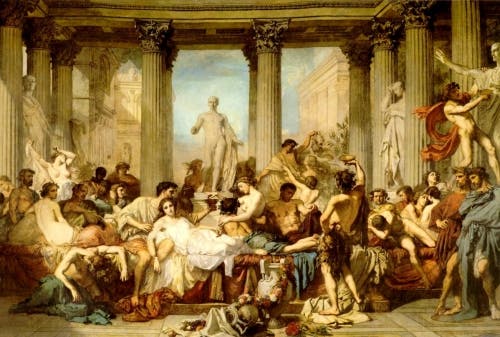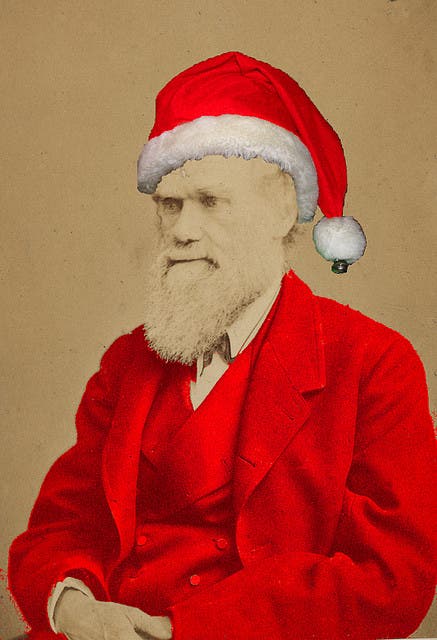This is a series of articles about Christmas we here at ZME Science will be doing all December. Our goal is to present interesting, little-known facts about the origins and history of Christmas. Curious to read more? Here’s something about the dreaded Yule Cat or the Catalonian tradition of the pooping nativity man.
Christmas – not the birth of Jesus, but a Roman celebration

There is still a lot of debate around when Christmas should be — that is when Jesus was born. It’s pretty much impossible to accurately pinpoint a date, but it’s highly unlikely that Jesus was born on the 25th of December, year 1 AD, as we’ve previously explained here. Most researchers believe he was born several years before, and possibly during the summer.
By all the information we have available, Christmas is probably based on a Roman celebration — Saturnalia.
Romans celebrated the holiday of Saturnalia, a week-long period during which Roman courts were closed, and Roman law dictated that no one could be punished for damaging property or injuring people during the weeklong celebration. Celebrations included feasting and singing (often naked in the streets), but also violence, rape, and sometimes, even sacrifices.
It was a rowdy period, and pretty much the opposite of what we consider Christmas-y today (except for the feasting). Roman Christians didn’t really like this.
They wanted to attract as many people as possible to their religion, but they also realized that the Romans aren’t going to give up on their favorite holiday so instead, they tried to incorporate it into Christianity; however, there was nothing about the celebration that was Christian, so they just chose the end date — 25th of December. To add more significance, they ‘labeled’ it as the birth date of Jesus, although there’s practically no evidence to support that date.
So right from the beginning, the date on which we celebrate Christmas customs is not biblical at all and has more to do with pre-Christian customs — though you could argue that doesn’t make it any less special.
The origins of the Christmas Tree

There’s really a lot of talk about the origins of the Christmas Tree. Some people claim it’s a German thing, and some people claim it was introduced by Martin Luther, but the truth is, the first customs related to Christmas trees are yet again non-Christian.
Pagans had long worshipped trees in the forest, or brought them into their homes and decorated them. In Poland and nearby areas, there was an ancient pagan custom of suspending at the ceiling a branch of fir, spruce, or pine — evergreen trees that can survive the harsh winter without losing their greenness. After all, winter may be a time of celebration now, but for the longest time, it was a time of survival and hardship. The branches were decorated with apples, nuts, cookies, colored paper, stars, ribbons, etc. People believed in the tree magical powers linked with harvesting and success in the next year.
Furthermore, as Enciclopedia Britannica explains:
“The use of evergreen trees, wreaths, and garlands to symbolize eternal life was a custom of the ancient Egyptians, Chinese, and Hebrews. Tree worship was common among the pagan Europeans and survived their conversion to Christianity in the Scandinavian customs of decorating the house and barn with evergreens at the New Year to scare away the devil and of setting up a tree for the birds during Christmastime.”
Celtic Druids tied fruit to the branches of live trees, and baked cakes in the shape of fish, birds and other animals, to offer to their god, Woden. However, the Christians once again adapted, and the Church incorporated traditions into the religion, unifying the similar, but slightly different traditions into the Christmas Tree we have today.
Mistletoe and Christmas
The mistletoe is Norse in origin, and it’s actually pretty tragic. It starts with Baldur a god in Norse mythology and a son of the god Odin and the goddess Frigg. Baldur was beloved by all, and yet he (and his mother) had bad omens about something that was about to happen to him.
So his mother Frigg had every object in every realm vow never to hurt Baldr. Everything swore to protect Baldur — except for the mistletoe, who was deemed too small and insignificant to matter. Baldur was later killed with an arrow made from mistletoe, after a conspiracy from Loki, the Norse god of mischief.
Mistletoe remained an important plant. In Celtic ceremonies, white-clad druids would cut down mistletoe growing from sacred oaks and sacrificed bulls to cure infertility. Along with several other plants, mistletoe became associated with fertility and somehow, paved the way for the ‘kissing under the mistletoe’ myth.
The origins of Christmas presents
In Pre-Christian Rome, the emperors compelled their most despised citizens to bring offerings and gifts during the Saturnalia (in December) and Kalends (in January). Later, this custom expanded to gift-giving to the general population. The Catholic Church gave this custom a Christian flavor by re-rooting it in the supposed gift-giving of Saint Nicholas.
The origins of caroling
During the Saturnalia, the rich feasted, consuming incredibly large quantities of food and alcoholic drinks. The not-so-fortunate would sometimes gather and sing at these feasts, in the hope of receiving something. This custom was probably perpetuated throughout the ages, as there are some mentions of the custom in various times, in various places in Europe.
There is another plausible explanation: the intoxicated people would often get naked and sing in the streets – I guess it depends on what kind of caroling you want to do.
Santa Claus and Saint Nicholas

Santa Claus has changed so incredibly much over the years it’s almost incredible to think where he started out. Almost certainly, the ‘original’ Santa Claus was Saint Nicholas of Myra a 4th-century Greek Christian bishop of Myra (now Demre) in Lycia, a province of Byzantine Anatolia, now in Turkey.
Nicholas was famous for his generous gifts to the poor, in particular presenting the three impoverished daughters of a pious Christian with dowries so that they would not have to become prostitutes. It’s undergone quite a transition to become the Santa Claus we know today, but then again, so has everything Christmas.
Everything we love to celebrate in December around Christmas time started out as a tradition, custom, or myth — and it’s changed quite a lot over the years.
Was this helpful?
